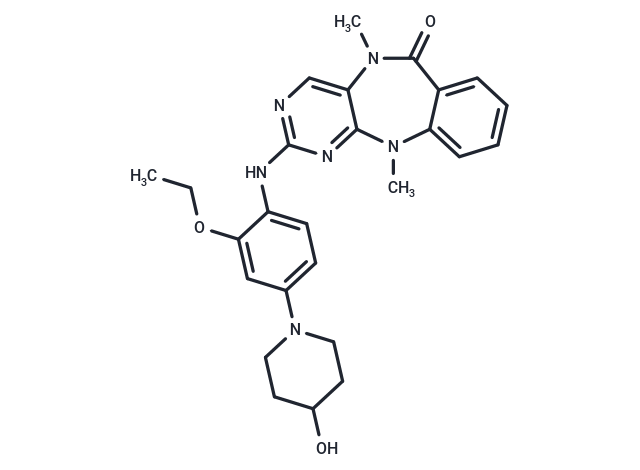Shopping Cart
Remove All Your shopping cart is currently empty
Your shopping cart is currently empty
XMD8-92 is an effective and specific BMK1/ERK5 inhibitor (Kd: 80 nM).

| Pack Size | Price | USA Warehouse | Global Warehouse | Quantity |
|---|---|---|---|---|
| 5 mg | $48 | In Stock | In Stock | |
| 10 mg | $68 | In Stock | In Stock | |
| 25 mg | $133 | In Stock | In Stock | |
| 50 mg | $247 | In Stock | In Stock | |
| 100 mg | $413 | In Stock | In Stock | |
| 1 mL x 10 mM (in DMSO) | $51 | In Stock | In Stock |
| Description | XMD8-92 is an effective and specific BMK1/ERK5 inhibitor (Kd: 80 nM). |
| Targets&IC50 | BMK1:80 nM(Kd), BRD4:190 nM (Kd) |
| In vitro | XMD8-92 significantly inhibits the growth of pancreatic tumor xenografts by downregulating DCLK1 and several of its downstream targets. At a dose of 50 mg/kg, administered intraperitoneally (i.p.), XMD8-92 blocks tumor cell proliferation and tumor-associated angiogenesis, resulting in significant suppression of tumor growth in both xenografted human and syngeneic mouse models. |
| In vivo | Hydroxysafflor yellow A (HSYA) inhibits the activation of hepatic stellate cells, while XMD8-92 can significantly block this inhibition and prevent the HSYA-mediated downregulation of MEF2C. By inhibiting the activation of BMK1, XMD8-92 significantly induces the expression of p21 in cells and inhibits the proliferation of cancer cells. |
| Kinase Assay | KiNativ profiling of XMD8-92 is carried out with both an ATP and ADP acylphosphate-desthiobiotin with the following modifications. HeLa cell lysates (5 mg/mL total protein) are incubated in the presence of XMD8-92 at 50 μM, 10 μM, 2 μM, 0.8 μM, and 0 μM for 15 minutes prior to addition of the ATP or ADP acylphosphate probe (5 μM final probe concentration). All reactions are performed in duplicate. Probe reactions proceeded for 10 minutes and the reaction stopped by the addition of urea and processed for MS analysis. Samples are analyzed by LC-MS/MS on a linear ion trap mass spectrometer using a time segmented "target list" designed to collect MS/MS spectra from all kinase peptide-probe conjugates that can be detected in HeLa cell lysates. This target list is generated and validated by prior exhaustive analysis of HeLa lysates. Up to four characteristic fragment ions for each kinase peptide-probe conjugate are used to extract signals for each kinase, and a comparison of inhibitor treated to control (untreated) lysates allow for precise determination of % inhibition at each point. A manuscript describing the details of this targeted mass spectrometry approach is in preparation[1]. |
| Molecular Weight | 474.55 |
| Formula | C26H30N6O3 |
| Cas No. | 1234480-50-2 |
| Smiles | CCOc1cc(ccc1Nc1ncc2N(C)C(=O)c3ccccc3N(C)c2n1)N1CCC(O)CC1 |
| Relative Density. | 1.301 g/cm3 |
| Storage | Powder: -20°C for 3 years | In solvent: -80°C for 1 year | Shipping with blue ice/Shipping at ambient temperature. | |||||||||||||||||||||||||
| Solubility Information | DMSO: 19 mg/mL (40.04 mM), Sonication is recommended. | |||||||||||||||||||||||||
| In Vivo Formulation | 10% DMSO+40% PEG300+5% Tween 80+45% Saline: 2 mg/mL (4.21 mM), Sonication is recommended. Please add the solvents sequentially, clarifying the solution as much as possible before adding the next one. Dissolve by heating and/or sonication if necessary. Working solution is recommended to be prepared and used immediately. The formulation provided above is for reference purposes only. In vivo formulations may vary and should be modified based on specific experimental conditions. | |||||||||||||||||||||||||
Solution Preparation Table | ||||||||||||||||||||||||||
DMSO
| ||||||||||||||||||||||||||
| Size | Quantity | Unit Price | Amount | Operation |
|---|

Copyright © 2015-2025 TargetMol Chemicals Inc. All Rights Reserved.